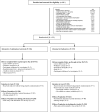Oseltamivir, amantadine, and ribavirin combination antiviral therapy versus oseltamivir monotherapy for the treatment of influenza: a multicentre, double-blind, randomised phase 2 trial
- PMID: 28958678
- PMCID: PMC5777222
- DOI: 10.1016/S1473-3099(17)30476-0
Oseltamivir, amantadine, and ribavirin combination antiviral therapy versus oseltamivir monotherapy for the treatment of influenza: a multicentre, double-blind, randomised phase 2 trial
Abstract
Background: Influenza continues to have a substantial socioeconomic and health impact despite a long established vaccination programme and approved antivirals. Preclinical data suggest that combining antivirals might be more effective than administering oseltamivir alone in the treatment of influenza.
Methods: We did a randomised, double-blind, multicentre phase 2 trial of a combination of oseltamivir, amantadine, and ribavirin versus oseltamivir monotherapy with matching placebo for the treatment of influenza in 50 sites, consisting of academic medical centre clinics, emergency rooms, and private physician offices in the USA, Thailand, Mexico, Argentina, and Australia. Participants who were aged at least 18 years with influenza and were at increased risk of complications were randomly assigned (1:1) by an online computer-generated randomisation system to receive either oseltamivir (75 mg), amantadine (100 mg), and ribavirin (600 mg) combination therapy or oseltamivir monotherapy twice daily for 5 days, given orally, and participants were followed up for 28 days. Blinded treatment kits were used to achieve masking of patients and staff. The primary endpoint was the percentage of participants with virus detectable by PCR in nasopharyngeal swab at day 3, and was assessed in participants who were randomised, had influenza infection confirmed by the central laboratory on a baseline nasopharyngeal sample, and had received at least one dose of study drug. Safety assessment was done in all patients in the intention-to-treat population. This trial is registered with ClinicalTrials.gov, number NCT01227967.
Findings: Between March 1, 2011, and April 29, 2016, 633 participants were randomly assigned to receive combination antiviral therapy (n=316) or monotherapy (n=317). Seven participants were excluded from analysis: three were not properly randomised, three withdrew from the study, and one was lost to follow-up. The primary analysis included 394 participants, excluding 47 in the pilot phase, 172 without confirmed influenza, and 13 without an endpoint sample. 80 (40·0%) of 200 participants in the combination group had detectable virus at day 3 compared with 97 (50·0%) of 194 (mean difference 10·0, 95% CI 0·2-19·8, p=0·046) in the monotherapy group. The most common adverse events were gastrointestinal-related disorders, primarily nausea (65 [12%] of 556 reported adverse events in the combination group vs 63 [11%] of 585 reported adverse events in the monotherapy group), diarrhoea (56 [10%] of 556 vs 64 [11%] of 585), and vomiting (39 [7%] of 556 vs 23 [4%] of 585). There was no benefit in multiple clinical secondary endpoints, such as median duration of symptoms (4·5 days in the combination group vs 4·0 days in the monotherapy group; p=0·21). One death occurred in the study in an elderly participant in the monotherapy group who died of cardiovascular failure 13 days after randomisation, judged by the site investigator as not related to study intervention.
Interpretation: Although combination treatment showed a significant decrease in viral shedding at day 3 relative to monotherapy, this difference was not associated with improved clinical benefit. More work is needed to understand why there was no clinical benefit when a difference in virological outcome was identified.
Funding: National Institute of Allergy and Infectious Diseases, National Institutes of Health, USA.
Copyright © 2017 Elsevier Ltd. All rights reserved.
Conflict of interest statement
All authors declare no competing interests.
Figures
Comment in
-
Finding the right combination antiviral therapy for influenza.Lancet Infect Dis. 2017 Dec;17(12):1221-1222. doi: 10.1016/S1473-3099(17)30537-6. Epub 2017 Sep 22. Lancet Infect Dis. 2017. PMID: 28958679 No abstract available.
References
-
- Bautista E, Chotpitayasunondh T, Gao Z, et al. Clinical aspects of pandemic 2009 influenza A (H1N1) virus infection. N Engl J Med. 2010;362(18):1708–19. - PubMed
-
- Galegov GA, Pushkarskaya NL, Obrosova-Serova NP, Zhdanov VM. Combined action of ribovirin and rimantadine in experimental myxovirus infection. Experientia. 1977;33(7):905–6. - PubMed
Publication types
MeSH terms
Substances
Associated data
Grants and funding
LinkOut - more resources
Full Text Sources
Other Literature Sources
Medical
Miscellaneous



